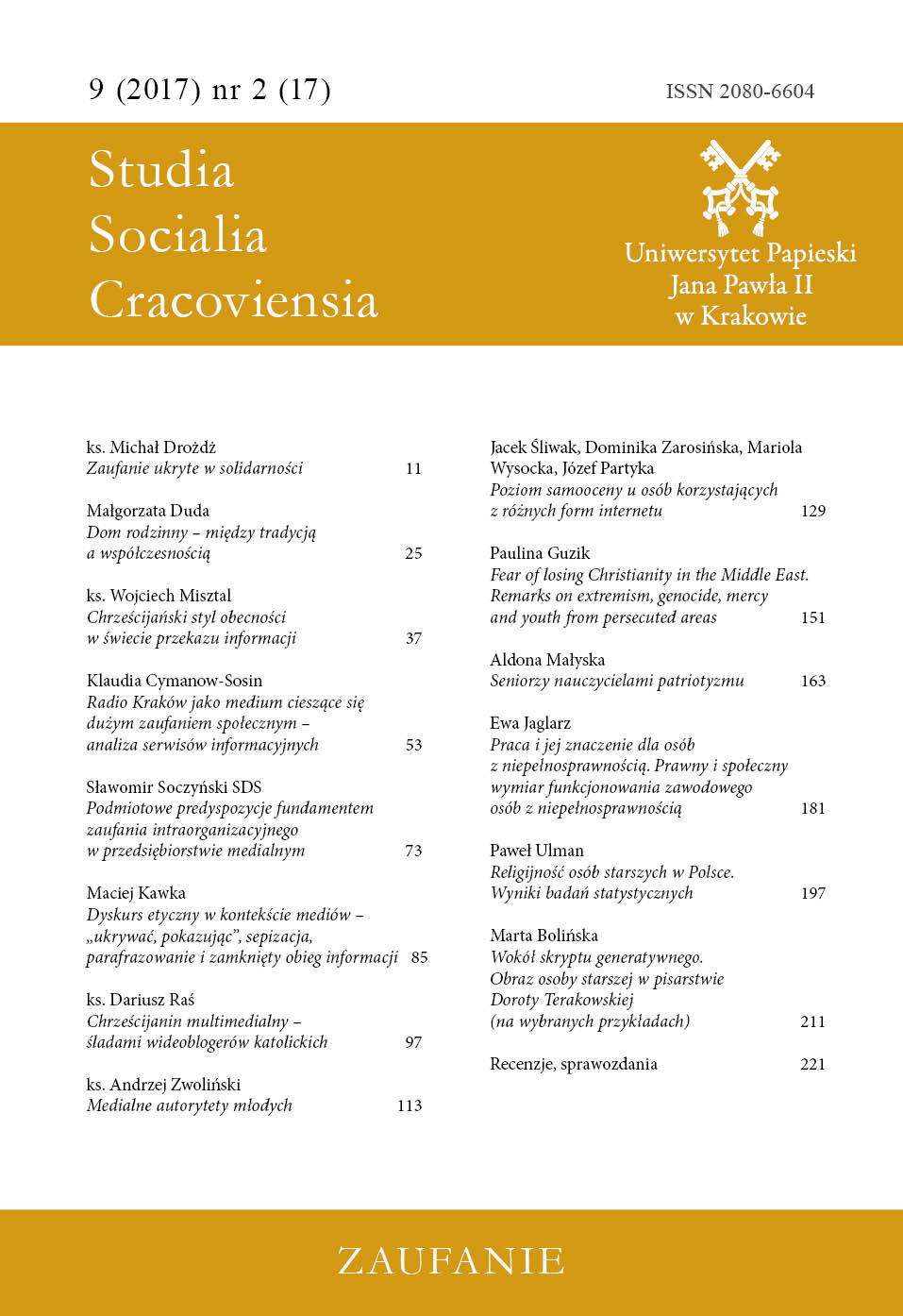Christian multimedia – on the trail of catholic video bloggers
DOI:
https://doi.org/10.15633/ssc.2458Keywords:
catholic, web, blogosphere, videoblog, faith, new media, Ryś, Szustak, Szymańska, ZagułaAbstract
It’s worth following Catholic videobloggers in the Internet. Evangelization via YouTube is characterized by the diversity of topics undertaken. Polish Catholic vlogs take up the following themes: from teaching the doctrine of the faith to lifestyle, profile issues to a simply responding to the questions of followers. It’s worth getting to know this aspect of the web. Communication via the new media opens new agora – meeting places with people. The new media open up a whole new sector for the new evangelization, and videoblogging is a very helpful tool in becoming an influencer, an opinion leader or guide who leads people to God though the chaos of the internet. It’s worth the new media meeting with God. It’s worth it that the new technologies talk more often about God.References
Benedykt XVI, Sieci społecznościowe: bramy prawdy i wiary, nowe miejsce ewangelizacji. Orędzie na 47. Światowy Dzień Środków Społecznego Przekazu, https://w2.vatican.va/content/benedict-xvi/pl/messages/communications/documents/hf_ben-xvi_mes_20130124_47th-world-communications-day.html (06.02.2017).
Blog – próba definicji, http://polonisty.blox.pl/2012/10/BLOG-proba-definicji.html (06.02.2017).
Chmielewska M., Religijni hipsterzy i Dobra Nowina. Wiara z przymrużeniem oka, http://www.influencer.pl/374/religijni-hipsterzy-i-dobra-nowina-wiara-z-przymruzeniem-oka (09.02.2017).
Franciszek, Adhortacja apostolska Evangelii gaudium.
Gwozdowska A., Vlog, teatr jednego aktora, http://www.rp.pl/Plus-Minus/306099919-Vlog-teatr-jednego-aktora.html#ap-2 (07.02.2017).
Gumkowska A., Blogi wobec tradycji diarystycznej. Nowe gatunki w nowych mediach, w: Tekst (w) sieci. Tekst – język – gatunki, red. D. Ulicka, Warszawa 2009, s. 230–243.
Kloch J., Przybysz M. M., Nowe media w Kościele, „Nowe Media” 8 (2014) 2, s. 65–71.
Laskowska M., Nowe media w służbie człowieka. Zarys problematyki w kontekście etyki i aksjologii mediów, „Teologia Praktyczna” 13 (2012), s. 123–137.
Liberacka A., Internet to sztuka wyboru, ttp://stacja7.pl/rozmowy/internet-to-sztuka-wyboru/ (09.02.2017).
Papieska Rada ds. Środków Społecznego Przekazu, Etyka w środkach społecznego przekazu, Watykan 2010.
Papieska Rada ds. Środków Społecznego Przekazu, Etyka w internecie, Watykan 2012.
Pikuła R., Szafiarka dla wierzących? Hipster katoliczka chce udowodnić, że „można być katolikiem i fajną dziewczyną”, http://weekend.gazeta.pl/weekend/1,152121,19741491,szafiarka-dla-wierzacych-hipster-katoliczka-chce-udowodnic.html (10.02.2017).
Raś D., Powołanie sieci, w: Bramy prawdy i wiary. Benedykt XVI o mediach, Kraków 2016, s. 177–186 (Colloquium z Teologii Mediów im ks. prof. Andrzeja Baczyńskiego, 1).
Socha-Jakubowska P., Katohipsterzy, https://www.wprost.pl/468741/Katohipsterzy (09.02.2017).
Wołkiewicz A., Testament Cyfrowego Imigranta – Benedykt XVI do mieszkańców cyfrowego świata, w: Człowiek. Media. Edukacja, pod red. J. Morbitzera i E. Musiał, Kraków 2013, s. 451–460.
Vlog to wyższa forma blogowania, http://studiumprzypadku.com/vlog-to-wyzsza-forma-blogowania-rozmowa-z-kamilem-newczynskim/ (10.02.2017).
www.biskup-rys.pl (09.02.2017).
www.hipsterkatoliczka.pl (09.02.2017).
www.influencer.pl (09.02.2017).
www.langustanapalmie.pl, (09.02.2017).
www.stacja7.pl (09.02.2017).
www.youtube.com (09.02.2017).
Downloads
Published
Issue
Section
License
Authors who publish with this journal agree to the following terms:
- Authors retain the copyright and full publishing rights without restrictions, and grant the journal right of first publication with the work simultaneously licensed under a Creative Commons Attribution 4.0 International License that allows others to share the work with an acknowledgement of the work's authorship and initial publication in this journal.
- Authors are able to enter into separate, additional contractual arrangements for the non-exclusive distribution of the journal's published version of the work (e.g., post it to an institutional repository or publish it in a book), with an acknowledgement of its initial publication in this journal.
- Authors are permitted and encouraged to post their work online (e.g., in institutional repositories or on their website) prior to and during the submission process, as it can lead to productive exchanges, as well as earlier and greater citation of published work (See The Effect of Open Access).

